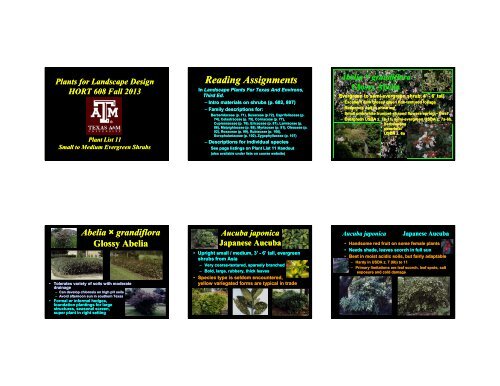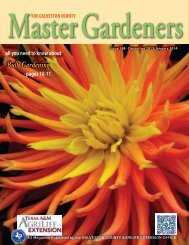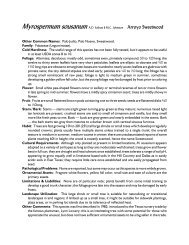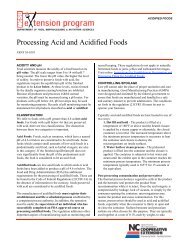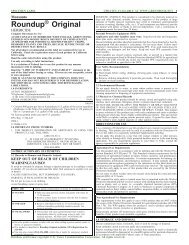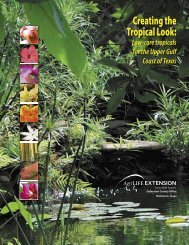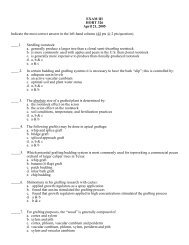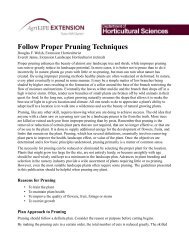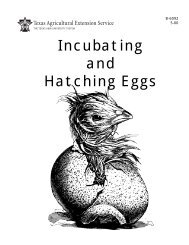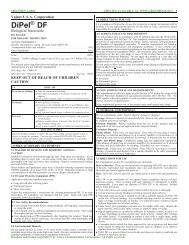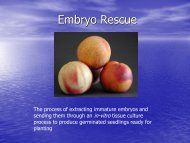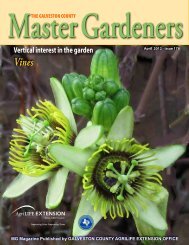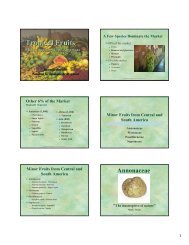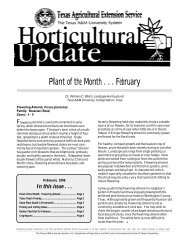Plant List 11 - Aggie Horticulture - Texas A&M University
Plant List 11 - Aggie Horticulture - Texas A&M University
Plant List 11 - Aggie Horticulture - Texas A&M University
Create successful ePaper yourself
Turn your PDF publications into a flip-book with our unique Google optimized e-Paper software.
<strong>Plant</strong>s for Landscape DesignHORT 608 Fall 2013<strong>Plant</strong> <strong>List</strong> <strong>11</strong>Small to Medium Evergreen ShrubsReading AssignmentsIn Landscape <strong>Plant</strong>s For <strong>Texas</strong> And Environs,Third Ed.– Intro materials on shrubs (p. 682, 807)– Family descriptions for:Berberidaceae (p. 71), Buxaceae (p.72), Caprifoliaceae (p.74), Celastraceae (p. 75), Cornaceae (p. 77),Cupressaceae (p. 78), Ericaceae (p. 81), Lamiaceae (p.86), Malpighiaceae (p. 88), Myrtaceae (p. 91), Oleaceae (p.92), Rosaceae (p. 99), Rubiaceae (p. 100),Scrophulariaceae (p. 102), Zygophyllaceae (p. 107)– Descriptions for individual speciesSee page listings on <strong>Plant</strong> <strong>List</strong> <strong>11</strong> Handout(also available under lists on course website)Abelia × grandifloraGlossy Abelia• Evergreen to semi-evergreen evergreen shrub, 4’ - 6’ tall– Excellent dark glossy green fine-textured foliage– Responds well to shearing– Small pink/white trumpet-shaped flowers spring – frost– Evergreen USDA z. 7b-<strong>11</strong>, semi-evergreen evergreen USDA z. 7a-6b,herbaceousperennialUSDA z. 6aAbelia × grandifloraGlossy Abelia• Tolerates variety of soils with moderatedrainage– Can develop chlorosis on high pH soils– Avoid afternoon sun in southern <strong>Texas</strong>• Formal or informal hedges,foundation plantings for largestructures, seasonal screen,super plant in right settingAucuba japonicaJapanese Aucuba• Upright small / medium, 3’ - 6’ tall, evergreenshrubs from Asia– Very coarse-textured, sparsely branched– Bold, large, rubbery, thick leaves• Species type is seldom encountered,yellow variegated forms are typical in tradeAucuba japonicaJapanese Aucuba• Handsome red fruit on some female plants• Needs shade, leaves scorch in full sun• Best in moist acidic soils, but fairly adaptable– Hardy in USDA z. 7 (6b) to <strong>11</strong>– Primary limitations are leaf scorch, leaf spots, saltexposure and cold damage
Berberis trifoliolataAgarito• Medium, 3’ - 5’, evergreen shrubs, USDA z. 7 (?) - 10– Leaflets reminiscent of holly (Ilex)) leaves green to blue-green– Stiff upright branches, irregular rounded mound• More heat, drought, & high pH soil tolerant than mostBerberis spp.• Tolerant of cotton root rotBerberis trifoliolata• Spiny leaves are maintenance liability• Grow on well drained soils only• Accent, barrier plant, naturalizing,xeriscapes, hedges, low screenAgaritoBuxus microphyllaLittleleaf Boxwood• Dense small broadleaf evergreen shrubs, 2’ - 4’ tall• Favorite genera for formal sheared hedges & topiary• Best on moist acidic organic soils, but takes lesser sites• Tendency to be short-lived in South, yellows in winterBuxus microphylla var. japonicaJapanese Boxwood• More heat tolerant than species type, best taxon in z. 8Buxus microphylla var. koreanaKorean Boxwood• More cold hardy than the species type, to USDA z. 5Buxus sempervirensCommon Boxwood• Larger, 4’ - 8’, than B. microphylla, , hardy in z. 6 -8 (9)• Less winter yellowing of foliage, than B. microphylla• Can reach 15’, with age; not very heat tolerant• Also known as English Boxwood, darker foliage• Typical boxwood used in formal designs in EuropeCotoneasterspp.Cotoneasters• Low spreading groundcovers (1’ tall)to large erect shrubs (15’ tall),deciduous to evergreen• Variable cold (USDA z. 5 - 7) andheat tolerance (z. 8 - <strong>11</strong>)• Flowers small & mildly attractive; ¼”to ½” diameter orange, red to blackfruit may be assets in summer/fall• Most species are better in sun thanshade, most need well drained soils,variable in soil pH and salt tolerance• Fireblight, spider mites, & root rotsare the main problems
Cotoneaster glaucophyllusGray Cotoneaster• An evergreen shrub with smallgray-green green leaves and irregularrounded canopy, USDA z. 7 -9• Typically 2’ to 4’ tall in ourregion, potentially larger• Mildly interesting pinkish springflowers & tiny orange-red red fruit• Valued as a gray-green green to silver-green accent• More drought, heat and fireblight tolerant than mostCotoneastersEuonymus japonicusJapanese Euonymus• Stiffly upright medium (mostly 4’ -6’ tall) evergreenshrub (picture on right is extreme example ofupright habit)• Typically used for yellow / white variegated varieties,but often reverts• Small-leaved leaved cultivars are substitutes for boxwoods• Only takes cold to USDA z. 8 (7a), is short-lived, andis disease / pest plaguedGalphimia glaucaThyrallis• Dense twiggy rounded to spreadingmostly evergreen to semi-evergreenevergreensmall to medium, 4’ to 6’ (9’) shrub• Green to blue-green foliage withterminal spires of yellow flowersGalphimia glauca Thyrallis• Flowers continue through growingseason, potential as summer annual• Reliably evergreen in z. 9b - <strong>11</strong>, asdieback shrub 9a (8b)• Use in sunny well drained sites• Propagation challenges withcuttings; pruning increases densityGardenia jasminoides• Small to medium, 2’ to 6’ tall,irregularly rounded broad-leavedevergreen shrubs;• Hardy in USDA z. 8b (8a)- 10• Limited cold tolerance, nematodes,whiteflies, mealybugs and a needfor neutral to acidic soils are thelimiting factorsGardeniaGardenia jasminoidesGardenia• Highly fragrant late spring / earlysummer white flowers are a key asset;unfortunately petals fade to dirty brown• Shield from afternoon sun & dryingwinds in our region; fair drought tolerance
Jasminum mesnyiPrimrose Jasmine• A trailing or arching moundedsemi-evergreen evergreen to evergreen shrub,with 4’ to 7’ long branches• Adapts to a wide range of soils &sites in USDA zones 8 - 10• Sun to shade, but has less flowers &a more open habit in shade• Nice cascading plant for low walls /cutbanks; tolerates severe pruningand is a rapid grower• Deer resistant and offers off-seasonearly spring flowers• Filler plant with few serious diseaseor pest limitationsJuniperus chinensis var. procumbens(Juniperusprocumbens)Japanese Garden Juniper• A prostrate Juniper serving similarpurposes in the landscape as J. horizontalisand J. conferta• Stiffer in texture & more irregularly undulatemounding than J. conferta & J. horizontalis• Good heat and drought tolerance onceestablished, best on high pH soils• Phomopsis blight susceptible• Adapted to USDA z. 5 (4) to <strong>11</strong>• A favorite of bonsai enthusiastsJuniperus confertaShore Juniper• Excellent low, 8”-12”(18”) tall spreading groundcover• Softer brighter green than most Juniperus spp.,some silver colored forms are available• Very salt tolerant, not asadapted to droughty hotsitesassomeJuniperussome Juniperus,wet soil & shade intolerant• Limited cold hardiness,USDA zones 6b (6a) - <strong>11</strong>Juniperus confertaShore JuniperJuniperus horizontalisCreeping Juniper• Low broad spreading groundcover,6” - 2’ tall, mounds in center• Some cultivars turn purple-brown in winter• Green to blue-green summer foliageJuniperushorizontalisCreeping Juniper• Hardy in z. 4 (3) - <strong>11</strong>• Many popularcultivars including‘Blue Rug’ and‘Plumosa’ types• Intolerant of shadeor poor drainage• Watch intermixingcultivars
Larrea tridentataCreosote Bush• One of the most widespread shrubs in the native floraof West <strong>Texas</strong> and SW USA, hardy USDA z. 8 (7) to <strong>11</strong>• Irregular broadly mounded small to mediumevergreen shrub, aromatic foliage• Interesting small yellow flowers and fuzzy fruit• Extremely drought,heat, and wind tolerant• Difficult to transplant,use small containergrown plants, intolerantof poor drainage• Will accept shearingLarrea tridentataCreosote BushLeucophyllumfrutescens<strong>Texas</strong> Sage• Small to medium evergreen native <strong>Texas</strong> shrub– Green to superior silver-gray foliage, 4’ - 8’ tall– Tendency to open leggy / scraggly habit if not pruned• Attractive bell-shaped pink-purple purple to white flowers– Peak bloom in spring, summer flushes after rain eventsLeucophyllum frutescens<strong>Texas</strong> Sage• Extreme heat & droughttolerance, takes high pH soils• Intolerant of poor drainage, avoidhigh relative humidity regions• Good xeriscape plant, hardy inUSDA zones 8 (7) - <strong>11</strong>Shorn as formal hedgeLeucophyllum candidumViolet Silverleaf• Silver white foliage and violet flowers• Smaller more compact plant than L. frutescens• Intolerant of poor drainage, high humidity, usein semi-arid id to arid portions of USDA z. 7 - <strong>11</strong>Mahonia bealeiLeatherleaf Mahonia• Coarse suckering broad-leaved evergreen shrubs– Sparsely branched, foliage is clustered on periphery– Variable height, 4’- 8’, slow growth, holly-like like leaflets• Terminal panicles of yellow flowers, late winter
Mahonia bealeiLeatherleaf Mahonia• Bloomy blue-black black drupe-likeberries in spring• Best on moist acidic soils inpart to medium shade– Soil adaptable as long assome moisture is available– Needs shade, but useful inUSDA zones 7 – 9 (10)– Very coarse textured– Intolerant of poor drainage,salts, & leaf scorch in sunMahonia aquifoliumOregongrapeholly• Broad-leaved evergreen medium / large shrubs– More refined in leaf and form than M. bealei– Beautiful dark glossy green holly-like like leaflets, turnbronze in cold weather; useful in USDA z. 5 - 8 (9)Mahonia aquifoliumOregongrapeholly• Similar fruit, but moreattractive synchronousflowering than with M.bealei• More cold hardy (z. 5), butless heat and droughttolerant than M. bealei• Good shade plant for z. 6& 7, marginal north andsouth of these locationsMalpighia glabra Barbados Cherry• A dense twiggy multi-stem fine-textured small tomedium, 4’ - 8’ (9’) tall, evergreen shrub in z. 9 (8b)-<strong>11</strong>• Small windmill-like like white pink to pink flowersfollowed by small red cherry-like drupes• Subtropical/tropical native of deep South <strong>Texas</strong>• Very heat, moderately drought and salt tolerantMyrtuscommunisMyrtle• Irregular upright oval evergreenshrub or small tree, 12’ to 15’ tall;often sheared to smaller size, 5’ to 6’• Classic myrtle of antiquity• Fine textured foliage, fragrant whiteflowers in spring/early summer• Excellent for screens, hedges, patioplanters, pots, background forperennial or color gardens• Substitute for Buxus in Deep Southand Southwestern USAMyrtuscommunisMyrtle• Historic / educational / scentgardens• Compact forms for knotgardens• Useful in USDA z. 9 (8b) – <strong>11</strong>,a favorite for coastal gardens• Scale insects are seriousproblem, spider mites / sootymold in hot weather• Intolerant of poorly drainedsoils
Nandina domesticaNandina• Evergreen upright suckering shrubs, 3’ -5’ (8’) tall– Dwarf forms can be only 1’ tall, but often lack flower & fruit• Finely divided foliage, very interesting appearance– Foliage often emerges red, yellow, or bronze; red in cold weatherNandina domesticaNandina• Attractive creamy white terminal flowerpanicles in spring• Bright red to orange-red red berries infall/winter– Profusion & effectiveness of fruit varies– Can become invasive in parts of southernUSA; full size sterile clones would help• Tough durable plant in more mesic regions,but is sometimes site sensitive in <strong>Texas</strong>• Best with morning sun /afternoon shade, andwell drained moist soils• Useful USDA z. 7(6) - <strong>11</strong>• A standard small, 2’ to 3’ tall, fine-textured evergreen shrub ofnorthern & western U.S. gardens• Used in high elevation West TXand Southwestern U.S. gardens• Classic yellow or white, pink,orange, to pink-red single flowers• Effective in USDA zones 2 -7• Most any well drained soils, fullsun to part shadePotentilla fruiticosaBush CinquefoilRaphiolepis umbellataIndian Hawthorn• Broad-leaved evergreen rounded shrub, 4’ - 6’ (10’)– Often sold in trade under name Raphiolepis indica– Many cultivars may be the hybrid Raphiolepis x delacourii• Dark glossy green foliage with attractive pink orwhite spring flowersEntomosporium leaf spotRaphiolepis umbellataIndian HawthornEffect of overhead irrigation• Full sun/part shade, some drought & pollutiontolerance, takes heat, salts, high pH soils• Entomosporium leaf spot can be devastating• Cold hardiness limited to USDA z. 8b (8a)- <strong>11</strong>• Requires fair drainage & air movementRhododendron spp.Azaleas orRhododendrons• America’s favorite genus of shrubs– Small to large (2’ - 10’) broad-leaved evergreenshrubs with rounded crowns, variably hardy z. 4 -9– “Azaleas” taxa tend to be smaller leaved, deciduous toevergreen, smaller clusters of blooms & finer texturedgrowth habit
Rhododendron spp.Azaleas or Rhododendrons• “Rhododendrons” taxa tend to have larger leavesthat are mostly evergreen, and fewer larger clustersof blooms, somewhat coarser growth habit– Require moist acidic soils, use only in East <strong>Texas</strong>– Most commercial taxa are hybrids, wide array ofspectacular spring flower colors, a few in summerRosa spp.Roses• Woody shrubs, herbaceous perennials, semi-climbers– Variably cold hardy z. 2 to 7, south to 9 or 10, evergreen to deciduous• Thorniness (prickles) variable among species & cultivars• In breeding for flower types; fragrance, site adaptability, &disease/pest resistance have been sacrificed; famous, butoften over-ratedrated genusRosa spp.Roses• Numerous disease & pest problems– Black spot, aphids, powdery mildew, Japanese beetle• Shrub / antique roses offer more versatility in useIs the cureworse than thedisease?Rosmarinus officinalisRosemary• Shrub (z. 8-<strong>11</strong>),subshrub/herbaceous perennial (z. 7)• Upright 5’ shrub or sprawling / weeping 2’ tall mound• Dark green, blue-green, or gray-green green foliage– Pungently aromatic, culinary herb, dried fragranceRosmarinus officinalisRosemary• Small flowers, light blue/light pink, mildly effective• Intolerant of wet soils, but moderately drought, heat,and salt tolerant; soil pH adaptable; full sun is best• Herb garden, hedging (tolerates shearing), rockgardens, xeriscapes, over low walls, containers
Questions / Comments?All material represented herein arecopyrighted by the author, or otherwise asindicated, with all rights reserved.For permission to reproduce text orimages from this presentation write:Dr. Michael A. ArnoldDept. of Horticultural Sciences<strong>Texas</strong> A&M <strong>University</strong>College Station, TX 77843-2133email ma-arnold@tamu.eduarnold@tamu.edu


